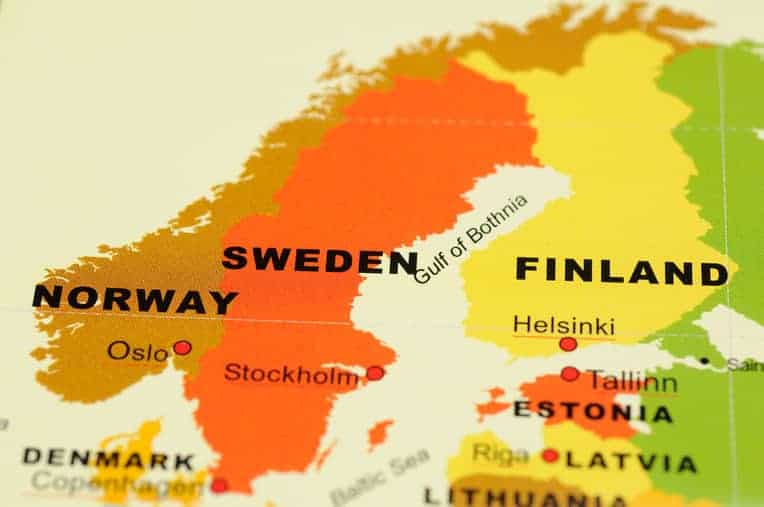Many people are aware that Scandinavia is the name of a geographic region in the world, so they naturally wonder if Scandinavia is the name of a language, too.
After all, a lot of places in the world have a dominant language whose name is associated with the region.
Scandinavia is not a language when “language” is defined as a body of words common to people that are part of the same community, geographic area, or cultural tradition.
“Scandinavia” is an unofficial name of a region in Europe that is made up of different people who speak different languages.
The people that live in Scandinavia speak multiple languages from different language families, including Norwegian, Swedish, Danish, Finnish, Icelandic, Faroese, and Sami.
Since some of these languages are similar to each other, some people refer to them collectively as a “Scandinavian language family.”
However, because of the countless dissimilarities that exist among them, they cannot be classified as one language. Keep reading to learn more.
The region of Scandinavia is one of the happiest places on Earth. See Why Are Scandinavian Countries So Happy? to learn more.

What are the Scandinavian languages?
Sometimes the phrase “Scandinavian languages” is used as a synonym for “North Germanic languages.”
Since the name “Scandinavia” is not an unofficial name, some people prefer different labels that are more technically accurate.
The term “Scandinavian languages,” however, may be more widely used in common language than other descriptions.
The languages of Norway, Sweden, and Denmark: The narrower use of the regional name, “Scandinavia,” is a reference to the northern European countries of Norway, Sweden, and Denmark.
Each of these countries has its own majority language:
- The majority language in Norway is Norwegian
- The majority language in Sweden is Swedish
- The majority language in Denmark is Danish
Are Scandinavian languages mutually intelligible? Norwegian, Swedish, and Danish are considered “mutually intelligible” languages. This means that speakers of one of these languages can often understand speakers in the other two, because of the similarities that exist between them.
In this sense, it is accurate to speak of a “Scandinavian language” grouping, though they are still separate languages.
What exactly is Scandinavia? See Is Scandinavia a Country, Continent, or Something Else? to learn more.

Minority languages in Scandinavia
Norway, Sweden, and Denmark also have native minority languages spoken within them, which are listed in the table below.
English is especially common in these countries, but it is not officially recognized, which has practical implications.
Government business, for example, is mostly done in the majority of languages, not English.
- 90% of Norwegian people speak English
- 90% of Swedish people speak English
- 91% of Danish people speak English [2]
Younger generations in all Scandinavian countries are more likely to speak English than older generations, mostly because of the increased availability of the internet in recent decades.
Younger generations are helping to spread the use of English throughout the region, including in schools and at workplaces.
The number of words in English is especially useful:
The English vocabulary is one of the biggest in the world with an estimated 750,000 words. That’s orders of magnitude bigger than the Scandinavian languages.
When a Swede, Dane, or Norwegian needs to describe something that a local word won’t cover, chances are they will simply use an English word. Some idioms and phrases have even crept their way into everyday use across Scandinavia, especially in advertising. [3]
English is expected to be more prevalent in Scandinavia in the next few decades as frequent English speakers have families and raise children who regularly speak the language a well.
| Country | Majority Language | Major Dialects | Language Family | Minority Language(s) |
|---|---|---|---|---|
| Norway | Norwegian, spoken by 95% of the population | Bokmal, Nynorsk, Tronder, East, West, North | North Germanic from Indo-European | Sami (officially recognized), Kven, Romani, Romanes (officially recognized minority languages) |
| Sweden | Swedish, spoken by about 90% of the population | Gota, Gotland, Svea, Norrland, South, East | North Germanic from Indo-European | Finnish, Sami, Romani, Yiddish, and Meankieli (officially recognized minority languages) [7] |
| Denmark | Danish, spoken by 98% of the population | Jutlandic, Insular, Bornhomsk | North Germanic from Indo-European | Faroese, Greenlandic, German (officially recognized minority languages) |
The languages of Finland, Iceland, and The Faroe Islands
In addition to Norway, Sweden, and Denmark, the broader use of the name “Scandinavia” also includes Finland, Iceland, and The Faroe Islands.
- The majority language in Finland is Finnish
- The majority language in Iceland is Icelandic
- The majority language in the Faroe Islands is Faroese
Like Norwegian, Swedish, and Danish, Icelandic and Faroese are products of the North Germanic language family, which is rooted in the Indo-European language base. Unlike those five countries, Finnish is rooted in the Uralic language base and as a result, has unique characteristics.
Finland, Iceland, and The Faroe Islands also have native minority languages spoken within them, which can be seen on the table below. English is also common in Finland, Iceland, and The Faroe Islands:
- 70% of the residents of Finland speak English
- The majority of Icelanders speak English [4], perhaps as much as 98%
- English is widely-used among younger generations in the Faroe Islands, but statistics are not available for the what percentage of their population (approximately 50,000 people), speak it [5]
As with Norway, Sweden, and Denmark, younger generations are more likely to speak English than older generations in these countries, because of the increased availability of the internet in recent decades. English is also introduced in schools in students’ primary years:
English is taught in Scandinavian schools from a young age. As soon as children have mastered reading and writing their native tongue, English is introduced.
The age varies by country and region but generally speaking, every student will have undergone at least a year of formal English language education by the age of ten. [6]
Likewise, in the next few decades, the use of English is expected to increase as English-speakers raise families and because of the proliferation of the internet.
| Country | Majority Language | Majority Dialects | Language Family | Minority Language(s) |
|---|---|---|---|---|
| Finland | Finnish, spoken by 89.3% of the population | Western (dozens of groupings), Eastern (15-20 groupings) | Finnic /Uralic | Swedish (officially recognized), English (not recognized), Russian (not recognized) |
| Iceland | Icelandic, spoken by 93.2% of the population | dialects non-existence, but there is some local variation [7] | North Germanic / Indo-European | English (not recognized), German (not recognized) |
| The Faroe Islands | Farosese, spoken by 90.8% of the population | Several native dialects exist on the island | North Germanic / Indo-European | Danish (officially recognized) [8] |
The people of Denmark, Sweden, and Norway are similar, but how much so? See Is Scandinavia a Race? to learn more.
The Sami language
The Sami people group live within the present-day borders of northern Norway, Sweden, and Finland. The Sami people are indigenous to the region.
Many historians believe their ancestors lived as nomads in the area prior to central and southern European explorers and settlers arriving in the region.
The Sami people speak a language by the same name — Sami — that is a language rooted in the Uralic language base.
Because of its shared history, Sami is more closely related to Finnish than it is to the other Germanic languages of Scandinavia.
There are many divisions of Sami, which all have uniqueness as well as similarities to one another.
According to the Encyclopedia Britannica, Sami languages are unique, but mutually intelligible, enabling all Sami speakers to understand each other:
Sami language, also called Lapp, any of three members of the Finno-Ugric group of the Uralic language family, spoken by the Sami (Lapp) people in northern Finland, Sweden, and Norway and on the Kola Peninsula in Russia. [8]
The Sami languages, which are mutually unintelligible, are sometimes considered dialects of one language.
The largest language, North Sami, spoken by about two-thirds of all Sami, is distributed over northernmost Finland, Sweden, and Norway.
East Sami is spoken in Russia on the Kola Peninsula and by two groups in eastern Finland: Inari and Skolt. South Sami is used by a few persons in central Norway and north-central Sweden.” [9]
In the late 20th century, Norway, Sweden, and Finland passed laws that preserve the use of Sami languages when interacting with the government for social services or legal matters.
It is believed that this will help preserve the Sami language as well as the history and traditions of the Sami people.
Other minority languages: Due to reasons such as geographic proximity and immigration, the countries of Scandinavia also have speakers of other languages in small numbers. Russian and German are two examples.
Minority languages such as these are unofficial, so no business or government processes incorporate them. They are mostly spoken in the home and at cultural gatherings, such as a church that conducts services in Russian or German.
Where in the world is Scandinavia? See Is Scandinavia in Europe? to learn more.
References
[1] Source
[2] Source
[3] Source
[4] Source
[5] Source
[6] Source
[7] Source
[8] Source
[9] Source
[10] Source
